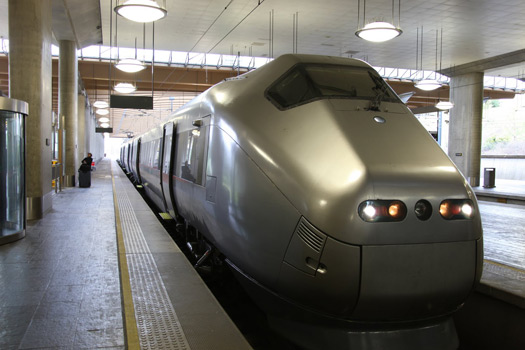 3,500 km for $20 on an Indian train
3,500 km for $20 on an Indian trainOslo Airport's mean-looking bullet train reaches the city center in 19 minutes. At 210 kph (130 mph) it is not the world's fastest — some of China'a new trains will soon reach nearly twice that speed — but Norway's is surely the most macho to look at.
Traveling on Oslo's mean-looking machine for 19 minutes costs about 20 euros ($30). In India, by contrast, that same amount buys you a 3,500km (2,175m) train ride from Kashmir to Kerala.
 India, 2010
India, 2010True, the north-south India trip takes three nights and four days, and the cheap carriages can be crowded. But one is bound to ask: Which country has the most advanced and resilient infrastructure?
My question is not rhetorical. Norway will decide next year whether or not to spend a big chunk of its oil revenue endowment on a nationwide extension of its high-speed train (HST) network. In the U.S., too, HST promoters argue that the country has fallen behind even underdeveloped countries in terms of infrastructure and that building HSTs creates jobs and increases productivity.
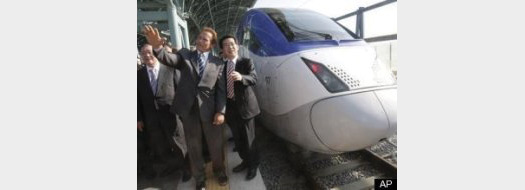 California governor Arnold Schwarzenegger inspecting South Korea's KTX high-speed rail system
California governor Arnold Schwarzenegger inspecting South Korea's KTX high-speed rail systemAt the Oslo Architecture Triennale last month, we discussed whether architects could influence this major infrastructure decision — or must they wait passively until there are stations and bridges to design?
My take is that "high speed railways, yes or no?" is a second order question. First order questions concern the kind of society Norway (or California) aspires to become in the decades ahead.
In the case of HSTs, three first order questions stand out in particular: Do the true system-wide costs of an HST network justify the investment? Is it sustainable to spend energy on the compression of space and time? And is it really just empty space out there?
1. TRUE COST INFRASTRUCTURE
As I've written elsewhere, modern mobility comes with a price — but the price tag is not visible and we travelers don't pay it. It is the biosphere that pays — in the form of impact and emissions that it absorbs from mobility, but which are not measured and are not charged to travelers.
We know this to be true because it's happened before. The development of the U.S. Interstate Highway System is a case in point. Its growth changed fundamental relationships between time, cost and space. These, in turn, enabled forms of economic development that have proved devastating to the biosphere and to society.
It is probably true that HST would facilitate another wave of productivity-driven economic growth — but if that pattern of growth is ecocidal, is it the right path to follow?
At face value, the argument for a Norwegian HST network is strong. The short route between Bergen in western Norway and Oslo, for example, is one of the most trafficked in Europe. It takes two flights an hour in each direction to carry over 5 million passengers a year — and the country's population is just 4.7 million.
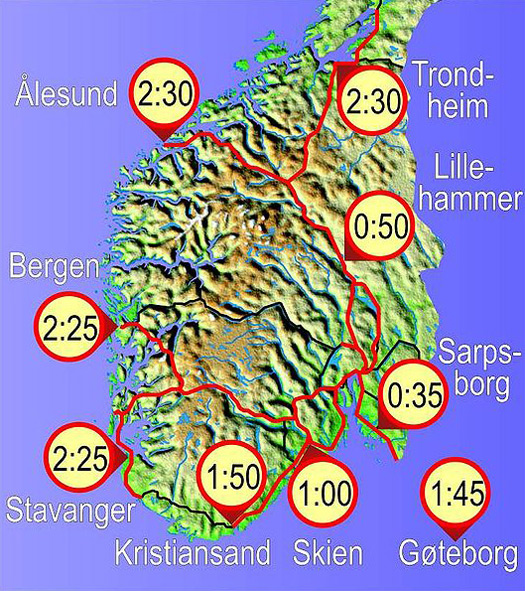 Journey times from Oslo of proposed HST network
Journey times from Oslo of proposed HST networkThe existing Oslo–Bergen train takes 6.5 hours, whereas an HST service would link the two cities in 2.5 hours. But when so-called true cost economics are applied to HST, the proposition that high-speed trains are environmentally far more friendly than cars and aircraft loses credibility.
When researchers at Martin Luther University studied the construction, use and disposal of Germany's high-speed rail infrastructure, they found that 48 kilograms (about a hundred pounds) of solid primary resources is needed for one passenger to travel 100 kilometers by Germany’s high-speed train.
A December 2009 Swiss study of the carbon footprint of high-speed railway infrastructure concluded that one passenger kilometer on Europe's high speed rail network is linked with 6.3g CO2 from the traffic infrastructure alone.
Another research group, this one at UC Berkeley, has measured the vast amounts of environmentally intensive materials that are needed to build an HST infrastructure. The Berkeley team analyzed hundreds of life-cycle processes — from construction equipment (for example, emissions from bulldozers, dump trucks, excavators and frontloaders) to the supply-chain effects of producing the concrete and steel needed to construct hundreds of miles of track and stations.
These immense resource flows were also studied by the Swiss reseach consortium (they were working for the International Union of Railways [UIC]). Reporting at the end of 2009, the UIC group assesed more than 40 modules of the rail track system: tunnel, viaducts, bridges, the track itself, energy and signalization equipment.
Prices really soar when an HST requires bridges, tunnels and winding mountain routes to cover difficult terrain. On the flat run from Madrid to Seville, the bridge-and-tunnel share is only 3.8 percent — but on the line between Wurzburg and Hanover, the share is 37 percent. In Norway, with its mountainous topography, the resource costs and carbon footprint of its tracks would surely be astronomical.
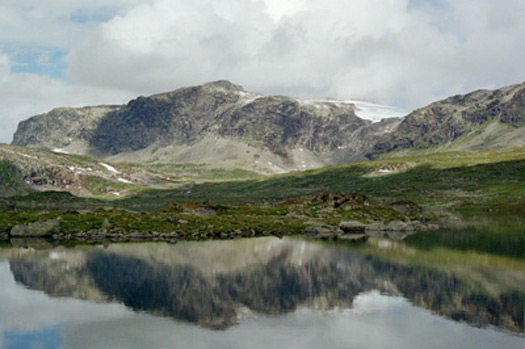 Norway's mountainous topography is a challenge for HST track builders
Norway's mountainous topography is a challenge for HST track buildersBut an HST system is more than the sum of its tracks. Among the other resource-intensive system footprints that necessarily accompany an HST line:
• Space: land is a finite resource, but we consume it as if it were limitless — especially for mobility. Space has to be consumed in large quantities to provide the infrastructure for high-speed travel — just as it does for new motorways and airports. John Whitelegg, a transport ecologist, found that in Switzerland the land allocation for ground transport is 113 m2 per person — compared to 20–25 m2 per person for all houses and gardens.
• Energy Supply: even if high-speed travel were not a climate change or social problem, high entropy transport systems depend on finite energy sources. Whether oil and gas are at a peak, or on a plateau, can be debated — but they are finite and no commercially viable renewable alternative offers the same volume and performance. How resilient is that?
• First-Mile/Last-Mile: Before a passenger boards a train, she has to get to the station using other means of transportation — the so-called first-mile element. And HST stations are rarely the end-point of her trip; more infra is needed to complete the "last-mile."
• Infrastructure of Stations and Parking: Many HST stations are multi-modal hubs; these entail complex and energy-intensive walkways, doors, escalators, lifts and the like to connect with local public transport and parking lots. HST terminals and stations also contain shopping malls, restaurants and other service centers not linked with the core service of transporting passengers.
• Security Costs: Enormous and growing material and human resources must be deployed to reduce the vulnerabilities of these complex systems to malfunctioning or attack.
2. TIME-SPACE COMPRESSION
Although time-savings provide the principal economic justification for HST schemes, the expansion of these networks does not, in the long run, give people more free time. On the contrary: We spend the same amount of time traveling today as we did 50 years ago — but we use that time to travel longer distances.
The fundamental problem with the HST is not that it burns too much of the wrong kind of fuel. The problem is that like the interstate highway systems that came before, it perpetuates patterns of land use, transport intensity and the separation of functions in space and time that render the whole way we live unsupportable.
Something similar happened in Norway before. When oil was first discovered in 1969, it spawned a generation of sprawling development. The suburbanization of Jæren swallowed numberless small, rural conglomerations. “Oilville” now stretches more or less continuously from Stavanger in the north to Egersund in the south.
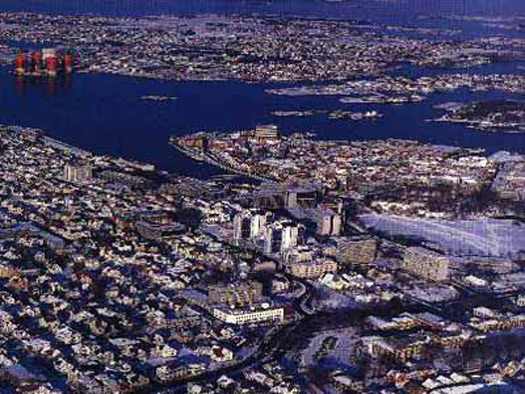 Stavanger, Norway — also known as “Oilville”
Stavanger, Norway — also known as “Oilville”Are there new ways to think about the space-time geography of Norway? To re-imagine its wide spaces and long distances as assets rather than as obstacles to be overcome?
Space, like oil is a finite resource. Worldwide, space is at a premium. Norway has lots of space; this makes her rich. So why try to compress this valuable national resource? Why try to make it smaller?
Maximum dispersal, after all, is the settlement pattern of the natural state of nature. As stone-age economist Marshall Sahlins has pointed out, minimizing conflict over resources, goods and women, dispersal is the best protector of persons and possessions. [Stone Age Economics Marshall Sahlins, New York, de Gruyter 1972]
In Oslo, we discussed whether to think of Norway as a mosaic of semi-autonomous zones. Could so-called peripheral cities be reconceived as new centres in their own right?
By re-examining what makes makes the regions of Norway distinctive, could new forms of value be discovered as the basis for establishing settlements?
3. FROM BIOSPHERE TO BIOTOPE: IT'S NOT JUST EMPTY SPACE OUT THERE
Shortly after the Oslo Triennale ended, a Natural Capital Action Plan [NCAP] was endorsed n Tokyo by major players such as China, India, Brazil and several EU nations.
An International Commission on Land Use Change and Ecosystems has developed a framework "natural capital accounts" that place financial values on components of the natural world such as undeveloped land, woodland, rivers and marshes.
The new framework is based on a three-year UN study of The Economics of Ecosystems and Biodiversity (TEEB). This found that the global economy is losing more money from the disappearance of forests, alone — $2-5 trillion per year — than through the banking crisis. The figure comes from adding the value of the various services that forests perform, such as providing clean water and absorbing carbon dioxide.
Back in 2008, when I first wrote about TEEB it was hard to interest people in climate change economics. But change is all about timing and tipping points. Although gross domestic product (GDP) has been the dominant measure of economic performance for generations, the movement to measure progress in new ways — that take account of natural resources and ecosystems — is rapidly gaining momentum.
TEEB places a top-down question mark on the assumption that the world is full of empty space that we can fill, at will, with things like HSTs. As we learn at ground level, too, that empty space is not empty after all, it flollows that many "clean" transport or energy systems are not inherently clean at all, but only somewhat less dirty than the fossil fueled systems they are purported to replace.
Bruce Pavlik, for example, author of The California Deserts: An Ecological Rediscovery has warned that, if we're not careful a rush to produce green energy could do irrevocable damage to some fragile California ecosystems. “California's desert lands are in some ways a perfect fit with the renewable energy industries necessary to combat climate change” Pavlik writes; “There's sun. There's wind. There's space. But the biologically rich but arid desert ecosystems are remarkably fragile.”
Once topsoil and plant life have been disrupted for the placement of solar arrays, wind farms, power plants, transmission lines and CO2 scrubbers, restoration would be cost-prohibitive, if not technically impossible — and in any case can take 100 years or more. Pavlik cautions that widespread desert construction, even of projects aimed at environmental mitigation, “would devastate the very organisms and ecosystems best able to adjust to a warming world”.
In the Nordic countries, too, I learned in Oslo, some pioneering designers are already sensitive to the hidden value in "empty" land.
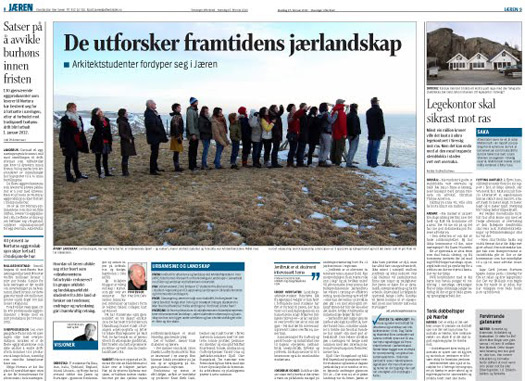 For Norwegian architeture students: it's not just empty space out there
For Norwegian architeture students: it's not just empty space out thereKnut Erik Dahl, for example, told me about a remarkable landscape study from 1988 by Peder Agger and Jesper Brandt titled The Dynamics of Small Biotopes in Danish Agricultural Landscapes. Hedges, roadside verges, drainage ditches, small brooks, bogs, marl pits, natural ponds, thickets, prehistoric barrows and other small uncultivated areas lying within and between the fields in the Danish terminology are named "small biotopes" — the smallest unit to be studied in the landscape.
Inspired by the discovery of these often-tiny biotopes, Dahl and his colleagues launched a research program: Appearing and Disappearing Landscapes:The Dynamics of Small Cultures. One researcher, Alex Walls, explained that the goal is “to design with flows of regional water, plants, animals. We want to combine people, goods, buildings and information to create a new city that is part of nature.”
The new thinking is that cities and city-regions need to reconceive themselves as elements of a bioregion — as a specific form of nature that embeds itself as much as possible in natural cycles and in which human settlements co-exist with, and are wholly dependent on, natural systems as well as human communities.
One of our speakers in Oslo, Allen Berger [author of Drosscape] was one of the invited experts in the first Jæren research. He made the point that “systemic is systemic; once one begins researching a single system it inevitably bleeds into other systems that cross-pollinate and hybridize even more systems, until dynamic feedback occurs.”
BACK TO URBAN NATURE
Some enlightened cities, such as Toronto, have already started to put the interests of these natural assets ahead of traditional planning priorities such as transportation infrastructures. The practical way to achieve this re-ordering of priorities is to put foodsheds and watersheds at the top of the agenda.
In design terms, this leads to a focus on “reactivating the existing” — adapting and enhancing what's already there rather than continue to accelerate capital and resource intensity. Alex Walls, in Norway, calls this approach “dirty” sustainability” — low-cost, hands-on solutions rather than high -ech answers. In policy-speak, this approach is about the creation of adaptive resilience in natural, human and technological ecologies. The focus here, is on decentralized and low -ntropy solutions.
I asked, at the top, which country — Norway, or India — has the most advanced and resilient infrastructure?
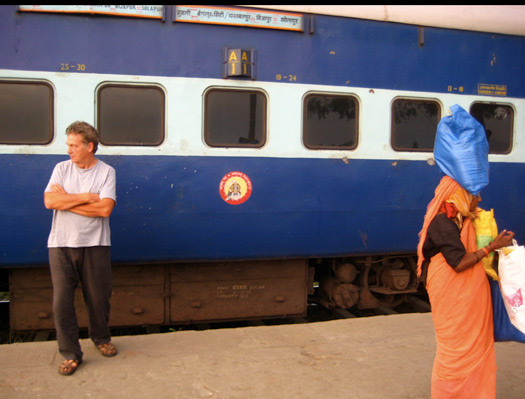 The author at the train station in Hampi, India, 2010
The author at the train station in Hampi, India, 2010My conclusion, which I guess is not well-hidden in the above, is that high-speed, high-entropy transportation systems take a country back to the past. They are not the way of the future. This is not to deny that there are many ways in which use of existing infra, such as India's amazing train network — or, for that matter, the trip from Oslo to Stavanger — can be enhanced.
But I'll return to those in a later post.


Comments [21]
11.08.10
08:38
Why, if we humans are very smart, don't plan a 'conscious' slow down period? So less people can live longer and better. It's a very complex subject. But every time I read an article like this, it makes me wonder whether all this solutions are just a immediateness rather than a deep and profound change in the way we deal with Earth and its resources and the other species too.
11.09.10
09:29
11.09.10
10:03
The massive hydroelectric projects of the 20th century will be dwarfed by industrial applications of wind and solar, and the earth will suffer just as surely (if in slightly different but perhaps more insidious ways) as it does under our present noxious clouds of carbon.
A return to low-energy systems, and a hyper-rationalization of the systems we already have, appear the most reasonable solution, and the term "dirty sustainability" has a great ring (and might encourage less techno-wishing and more fucking...)
We could wake up tomorrow using off-the-shelf technology and drive cars that get 150mpg using an established power infrastructure; a move that would actually reduce energy consumption (as opposed to the resource hogging, rare-earth demanding, coal-fired powering, all-new distribution network construction project of the all-electric vehicle fleet.)
11.09.10
12:18
"The problem is that like the interstate highway systems that came before, [HSR] perpetuates patterns of land use, transport intensity and the separation of functions in space and time that render the whole way we live unsupportable."
You're 'paving over' something crucial here- that different modes of transport do fundamentally different things. High Speed Rail is far more space efficient than interstates could ever hope to be. Two conventional rail lines can transport the same tonnage in an hour as six freeway lanes, with far less energy intensity. Furthermore, when passengers arrive at cities by train, the land use patterns tend to be far more compact, and 'walkable' if you will. If anything, at least in California, the current auto-centric dogma already fulfills your prediction to the fullest extent. Rail in general tends to inspire better land use patterns, if not the panacea this article yearns for.
"Although time-savings provide the principal economic justification for HST schemes, the expansion of these networks does not, in the long run, give people more free time."
We may very well use the same amount of time to travel as we have for the past fifty years- but you forget to differentiate your modes once again. While aboard a train, one is not driving, and one is not standing in a security line. On most modern systems, you can use the internet, eat a meal, or take a shower. Sure we spend the same amount of time on travel, but you can do so much more with your time when traveling by train.
I also fail to understand how you didn't take into account the sheer amount of energy all of those flights soak up between Bergen and Oslo. High Speed Rail does consume large amounts of energy, but nevertheless I believe they would render significant energy/pollution savings over the current system, especially when considering that an HSR system tends to dismantle the air market for when two cities are an appropriate distance apart.
One can't disagree with your argument for overpopulation, but I suppose I'll just have to wait for your next post to see what you think we ought to do about our currently impossible situation. My bias is clear, I believe that trains, and yes, sometimes fast trains, offer elegant solutions to many of our sprawling problems even in the 21st century. What's this talk about "moving towards the past" anyways? Seeing as every major mode of transport we use today started to develop a little over a century ago (if we're purists and count up from the Wright Bros. and Gottlieb Daimler, ect. ect.), your point is a nebulous one.
11.10.10
01:09
11.10.10
11:34
A second is about the beauty of Indian trains. I grew up in India - took the coromandal express from Visag to Kodaikanal along the east coast to get to school. They are wonderful and the infrastructure is comprehensive. However, they aren't what they used to be. Getting a ticket is very difficult and often you have to book months in advance for a proper confirmation.
Thirdly, I don't know how we can discuss high speed rail without talking about inner city transportation in the American context. American cities were abandoned and eviscerated two generations ago and the inner cities filled with poor people. Public transportation became a dirty word and people suffered. High speed rail makes sense if there is something - ie a city - to arrive at. And a good city has a working subway and surface rail system. I don't need to point out that most American cities don't have this. It brings me back to my first point: why new ideas about new social agglomerations when we have failed utterly to build basic working cities for our populations during the second half of the 20th century?
11.11.10
03:23
Felipe: of course population is important factor - but even if we all stopped breeding today, our economy would remain a doomsday machine
Rafael: I do not suggest that Indian trains cannot be improved, only that, as a system, they make more sense than High Speed Train systems
Mr Downer: I agree, but we could also wake up and start devising ways to remove the need to move about so much in the first place
J A Z: you're right to raise the flights between Bergen and Oslo. As with Indian train commuters, it's incumbent on me to say what, practically, might replace the systems I'm criticising. Which I will due here in due course.
Andrew: my mistake, haven't got the hang of the input system at DO yet. Sorry.
Mr Rudd: as it happens I am not an academic [as my teachers at school and university would happily testify]. I'm more of a storyteller. But I've learned the hard way that unless I include grown-up data and references in my stories, people don't take them seriously. As for Indian trains: yes they can be shabby, and the booking system is clunky - but my point concerns energy and resource use per traveler. On that, they shine. As for US cities: you're right, of course - but many interesting ideas are emerging about how to re-imagine and re-fit suburbia in ways that obviate the need for millions of people to move about so much.
11.12.10
02:34
In a way you can better it if it already exists....than start creating new altogether when lack that infrastructure.
(P.S:) there's difference b/w lack of infrastructure and bad infrastructure.
11.12.10
03:19
11.22.10
08:56
12.02.10
03:47
Intutively, I would go for a "highly" efficient system even if Capex and 'ecocide" load of capex is high.
I think the key question should be "can we reduce the need for 5 million people to travel between Oslo and Bergen every year?"
12.02.10
07:48
And, yes John, i did feed in the two stations that should connect Kashmir with Kerala by rail to check the price....and this is what i got :
"No trains could be found between SRINAGAR T CNTR and Trivandrum for 09/12/2010. Please try searching for some other date and/or some other pair of station(s)."
I tried all the dates till Christmas and i still got the same above response...so , which train were you referring to ?
I thought may be Srinagar is not connected but Jammu is directly to T'DUM...and fed in Jammu Tawi...and this is what i got ...
"No train runs on the filters you have applied on the selected class.Please modify the filters or the class."
The class i tried in both cases was THIRD ECONOMY NON-AC ...because that is the cheapest class...the one Gandhi travelled in ..So, John, where did you get this quaint idea that you can connect between KASHMIR AND KERALA DIRECTLY AT $30 ??? IN ANY CASE IF YOU DID CONNECT IT WOULD NOT BE "A TRAIN RIDE" AT ALL ...but many different train rides ...and some experiences that can take you for a real ride ...that i look forward to exploring in India WITH YOU soon as you return ...... ...AND LET ME ADD , TOO, JOHN ...that you are likely to piss off the Indian Government by your desire to "obviate the need for millions of people to move about so much"...considering that bureaucrats in the country have been given full leeway to not only increase the number of tourists to this country BUT ALSO TO PROUDLY PUBLISH BOOKS ON HOW THEY, IN THE FACE OF SUCH ADVERSITIES AS THE AFGHAN WAR AND THE 9/11 DISASTER HAVE BEEN ABLE TO FLOOD THE COUNTRY WITH TOURISTS BY CREATING SPECTACULAR AD CAMPAIGNS AND MAKING EVEN MORE SPECTACULAR CLAIMS IN THE NAME OF "BRANDING INDIA" ...one such book is doing the rounds, titled precisely that* , bandying about an increase in tourists in these words: "in 2008 India got 5.38 million visitors compared to 2.54 million in 2001", which would be in your words far too many people moving about far too much ! * "Branding India: an incredible story" / Kant, Amitabh. --Noida: Harper Collins, 2009...View of such spectacular gains, chances that "hedges, roadside verges, drainage ditches, small brooks, bogs, marl pits, natural ponds, thickets, prehistoric barrows and other small uncultivated areas lying within and between the fields (that) in the Danish terminology are named "small biotopes" — the smallest unit to be studied in the landscape", will have to make way for a foraging dinosauric tourist habitat is a very strong possibility ...
12.02.10
05:59
On "First-Mile/Last-Mile"- having worked on HSR efforts in both US and Europe, I'm convinced that in the US HSR should be a Drive-on Drive-off system. Prizing people from their cars, to get on a train to be subsequently roughed up by a rental car company at their destination will be a tough sell. An intersection of the Chunnel concept with something of the best of those Amtrak California Zephyr trains might offer a convincing solution. You're not parted from your car, you whistle across the American landscape at 180 mph with time to think, and at destination you're back in your car filtered into existing infrastructure as you might at Calais.
12.04.10
12:39
Anything taken to an extreme is unhealthy. Presumably there can be too much transportation -- but who decides how much? And for whom? If high-speed travel becomes the exclusive ability of the rich and powerful, how do we ever rebalance the political score. If our need is for less travel, then (the article suggests) the only solution is the devolution of large regions and nations, so that each is self-standing, isolated, and complete (based on bioregionalism and population control).
Could be, but this solution is so beyond realization in time to make a difference before the climate solves it once and for all -- for all -- that it's discussion is one of those things that would best take place on a long train ride, to kill time. It's a short story, might as well be a fast train.
12.07.10
01:47
Mitch, I'm not sure I consider the Indian trains to be the worst - although I do confess that in the Indian train in that picture I was traveling first class sleeper...
sd, I would not argue that toilets on some trains - including Indian ones - can be pretty grim
Vinod, the challenge we face is that "operating costs" as presently calculated do not include environmental impacts. I agree with your final point 100%
Nataranjan, I'm mortified if I gave an incorrect cost for the long India journey. My source was an Indian friend who spends half his life on your railways and knows an awful lot about the best deals.
As for the bigger issue: I do not suggest that we stop people traveling - I am well aware that many millions of Indian workers have no choice but to move around the country looking for work - but if we are to have any chance of building a sustainable world it has to be based on someone paying the true costs of the moving that we do
Nick, the stress-free solution you describe sounds attractive - but my point still stands: what does such a journey really cost? if we don't pay it, the likilhood is that the planet will pay
Bob, just because some investments are worse than HST does not make HST an environmentally virtuous system. As for my proposal that we travel less: the idea may be pat, but given the constraints imposed by the laws of nature and thermodynamics, I don't see that we have much choice. But given the constraint of less travel, there's still a lot we can do to enhance the quality of communicating by other means.
12.07.10
10:58
www.indianrail.gov.in/cgi_bin/inet_srcdest_cgi_date.cgi
www.indianrail.gov.in/cgi_bin/inet_trnpath_cgi.cgi
www.indianrail.gov.in/inet_srcdest_clus.html
While you are at it, you may also want to check your numbers between Oslo and Bergen. My friends tell me that between 6 a.m. in the morning and 10 p.m. at night the number of flights between the two are 40 at best. Should each flight carry 200 passengers, the annual carriage would be not 5 million as you estimated but 3 million, . That's the number of passengers the local Delhi Metro(NCR) ferries every two days! That is if it is 200 per flight..if 100 per flight , which is what my Norwegian friends say is the norm, then we do that on our DMRC in a single day!
12.24.10
03:26
12.24.10
05:13
Of course, your core point is hugely relevant...which is the reason for this involved debate! And thank you for bringing Indian Railways into focus. No apologies needed because the ticket price from Jammu, if not Srinagar, to Kerala is indeed $13! But it’s one thing for an Indian to showcase this as "Affordable India" and quite another to travel by it. I may mention here that guys like me must bear part of the blame. It started 15 years ago when in a presentation in Switzerland I made the casual remark that at the price of a train ticket from Geneva to Vevey and back one could do a pretty good tour of India! The exchange rate at that time was INR 60 to a Swiss Franc and CHF 120 (the one way fare from Geneva to Vevey was CHF 60) fetched INR 7200. With that princely sum you could do over 43,000 Kms at 6 Kms. to a Rupee (current Jammu to Trivandrum)! My Nestle colleague, R3 Ronaldo, when he heard this was so impressed that he exaggerated my “pretty good tour of India” to "Grand Tour of India" to illustrate just how expensive the rail was in Switzerland! The rest is, as they say, Indian Railway mythstory!
Have a great New Year!
Nataranjan Bohidar
+91 9811112220
12.26.10
03:15
p.s. Darly Koshi, who now lives nearby here, once used to be Director NID , Ahmedabad from where many of my school students/ junior colleagues have graduated...you shld get in touch with him /them !
03.08.11
01:40
03.30.11
01:20